Early results from trials addressing topsoil and subsurface acidity in South Australia
Early results from trials addressing topsoil and subsurface acidity in South Australia
Author: Brian Hughes, Andrew Harding (PIRSA), Nigel Fleming (SARDI), Bonnie Armour, David Woodard (PIRSA), Sam Trengove, Stuart Sherriff (Trengove Consulting) and Brett Masters (SARDI) | Date: 09 Feb 2021
Take home messages
- At new trial sites yield improvements in acid sensitive crops, such as lentils, are being observed in the second year after lime application.
- At old existing trial sites more rapid and greater yield increases were observed in response to lime sources with finer particle size and higher neutralising value, higher application rates, and where lime was incorporated.
- At sandy trial sites soil modification treatments such as claying, ripping and spading have had a greater yield response than top-dressed lime in the first instance.
- Lime has increased the availability and uptake of molybdenum, which is important for nodulation and has decreased levels of plant manganese.
- At several trial sites, results have shown Scepter wheat to be very tolerant of acid soils.
- In low rainfall areas greater time is required for lime dissolution and effectiveness at increasing soil pH, but liming marginally acid soils can be considered as a medium-term preventative treatment.
Background
Areas affected by soil acidity are expanding across South Australia’s (SA) cropping zone particularly where poorly buffered soils (e.g. sands with low organic matter) are being used for intensive cropping rotations with high yields and high nitrogen fertiliser inputs. Under no-till systems, soil acidity appears in a patchy distribution both horizontally across the paddock and at depth. pH stratified profiles are common on some soil types and after liming, often with an acidic layer around 7 and 15cm depth. pH mapping has been expanding to detect in-paddock variation, however, subsurface and stratification issues are often not detected with current soil testing procedures.
The GRDC investment ‘New knowledge and practices to address topsoil and subsurface acidity under minimum tillage cropping systems of South Australia’ brings together project partners from the Department of Primary Industries and Regions (PIRSA), the Department for Environment and Water, the University of Adelaide, Trengove Consulting, Murray Lands and Fleurieu Landscape Boards, Penrice Quarry Products and AgCommunicators to research soil acidification across a range of soils and farming systems in SA. The project aims to generate new information regarding lime movement and its effectiveness when applied to different soils and environments in modern farming systems.
Since the project started in 2019, 11 new trial sites have been established across SA, including several sites where soil acidity is a newly emerging issue. Other project components include the assessment of old trials, case studies and demonstrations regarding lime movement, establishing new soil monitoring sites, a PhD student focussed on infra-red soil measurements in-paddock, improved pH indicator tests and other indicators which can be used for assessment of paddock variability, and the establishment of the new soil acidity website and extension material.
The project is reviewing key issues when managing acidification under modern farming systems including, understanding soil variation, pH stratification and impacts, lime quality and rates, incorporation/cultivation impacts, complementary products, determining acidification rates and liming requirements in low to medium cropping rainfall areas.
Method
Trial sites have been established in a range of SA soil types, rainfall zones and liming histories, with two sites having been limed previously (Table 1). Elemental sulphur treatments have been applied to most sites to accelerate acidification and mimic future productivity losses if treatment is not undertaken.
Table 1. Replicated trial sites being monitored in SA.
Site – year established | Soil type – pHca by depth increments- 5cm | Main treatments |
|---|---|---|
Wirrabara 2015 | Sandy loam over brown clay- 5.5/4.3/4.1/4.4 | lime types, rates, cultivation 2019, sulphur |
Koppio 2017 | Sandy clay loam with ironstone gravel over yellow- red clay 4.7/4.4/4.2/4.7 | subsurface lime, rates, organic matter, ripping, sulphur |
Kapunda 2019 | Fine sandy loam over red-brown clay 5.2/4.5/4.7 | lime type, rates, cultivation, gypsum, sulphur |
Koonunga 2019 | Sandy loam over red-brown clay 5.2/4.2/4.5/5.1 | rates of lime, cultivation, deep cultivation, gypsum, deep calciprill, CaNO3 demo, sulphur |
Sandilands 2019 | Loamy sand with ironstone gravel over red clay 4.4/4.1/4.5/5.1 | rates/types of lime, cultivation, gypsum, local lime, ripping, sulphur, ripping |
Bute North1 2019 | 30cm sand over clay 6.1/4.8/4.8/5.2 |
|
Lameroo 2020 | Thick sand over clay 5.0/4.5/4.6 | lime rate, incorporation methods, biochar, clay, lime types |
Brooker 2020 | Shallow sand over clay 5.3/4.5/5.7/6.7 | lime rates, sulphur, incorporation |
Spalding East 2020 | Light sandy clay loam sodic Red-brown Earth 4.4/4.4 | lime rates, comparison limes, cow manure, incorporation |
Yumali 2020 | 40cm sand over clay 5.0/4.6/4.8/4.8 | lime rate/type, sulphur, incorporation by rotary hoe, biochar, clay, deep ripping |
Mallala 2020 | Shallow sandy loam sodic Red-brown Earth 4.8/4.5/4.5 | lime rate/type, sulphur, incorporation by offset disc, biochar x 2 sources, chicken manure, gypsum |
In addition, demonstrations have been set up at Karte and Yumali, and new liming trial sites at Kybybolite, Sherwood and Kangaroo Island through an SFS/NLP/GRDC project.
Results and discussion
Impact of treatments on dry matter and yield
New sites
In 2020 lentil dry matter (Figure 1) and yield (Figure 2) responses to lime applied in 2019 were observed at Sandilands on a brown loamy sand over red clay. A combination of high-quality lime at a high rate with cultivation, gave the best result. At Bute on a sand over clay, yield responses to ripping, inclusion plates and spading were observed (Figure 3) but did not influence the lime response. The lime product trial showed a dry matter response to Spalding and Angaston lime products, however, this response did not result in a significant yield increase (Figure 3). Koonunga and Kapunda trial sites were both sown with Scepter wheat which showed little response to lime due to its acid tolerance, although nutrient levels in plant tissue were affected by the treatments.
Old sites
Old trial sites located at Wirrabara and Koppio generated mixed results. Both trials were sown by the grower, predominantly with acid tolerant varieties. After three years, results from Wirrabara showed that finer quality lime gave the best results accumulated over several years while the best results from Koppio followed treatment with subsoil organic matter, ripping and lime.
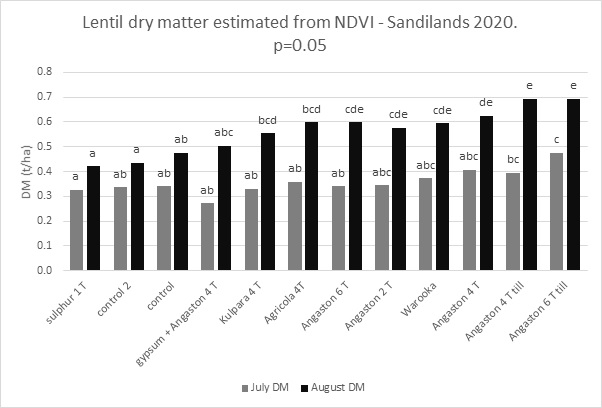
Figure 1. Mean dry matter of lentil at Sandilands, July and August 2020.

Figure 2. Mean grain yield of lentil at Sandilands 2020.
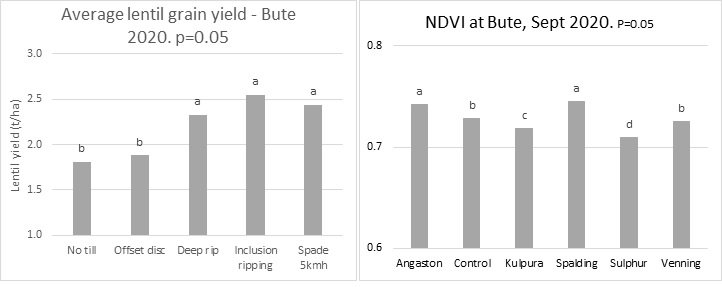
Figure 3. Grain yield of lentil following soil modification (left) and normalised difference vegetation index (NDVI) of lime source trial at Bute 2020 (right).
2020 sites
Several trial sites established in 2020 showed interesting results although increases in yield and/or dry matter were mostly due to factors other than lime.
The Mallala trial site sown to lentil, showed a significant increase in dry matter with chicken manure or fertiliser treatments. The poorest yield was in response to the elemental sulphur treatment. Nodulation of the lentils appeared more prolific under the manure and lime + cultivation treatments, indicating lime may have a small impact. While trends continued to harvest, the yield differences between treatments were not significant at p=0.05 due to the variability across the site.
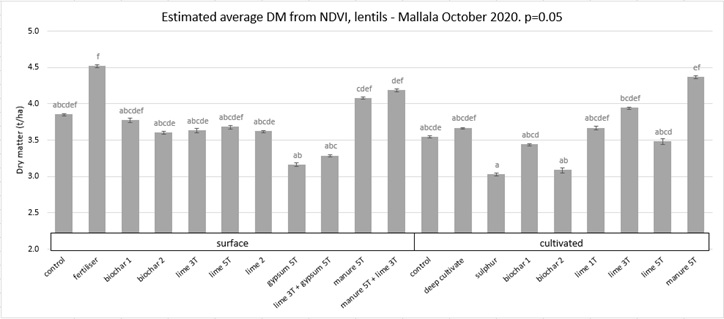
Figure 4. Average dry matter in lentil estimated from normalised difference vegetation index (NDVI) at Mallala October 2020
The Spalding East trial site showed a good barley dry matter response to manure and incorporated lime, but the yield response was not significant, due partly to the impact of frost. Normalised difference vegetation index (NDVI) highlighted a dry matter response to broadcast products in 2020, however a small response to incorporated lime products was observed.
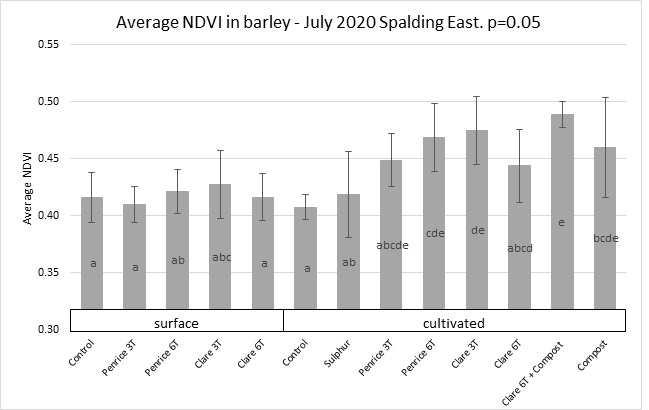
Figure 5. Average normalised difference vegetation index (NDVI) of barley in response to numerous treatments at Spalding East July 2020.
The Yumali trial site on a thick sand over clay showed large growth differences in barley throughout the season with the highest grain yield on a lime plus ripping and cultivation combination. Claying and deep ripping only produced the next highest yields. All surface lime treatments, regardless of rate, produced similar results to the untreated control, highlighting the lack of a rapid lime response without incorporation in this environment.

Figure 6. Grain yield of barley in response to numerous treatments at the Yumali trial site in 2020.
There were no significant responses at Lameroo and Brooker during 2020. The Lameroo site was sown to oats which are considered acid tolerant.
Impact of treatments on trace elements
It is well known that the availability of molybdenum (Mo) in soil declines with acidification. In 2020 plant testing was undertaken at several of the sites where the positive impact of liming on Mo uptake was observed, particularly in legumes where it impacted nodulation rates substantially. Figures 7 and 8 indicate large increases in Mo availability and uptake in lentil and barley, particularly where high rates of lime were mixed into the soil.
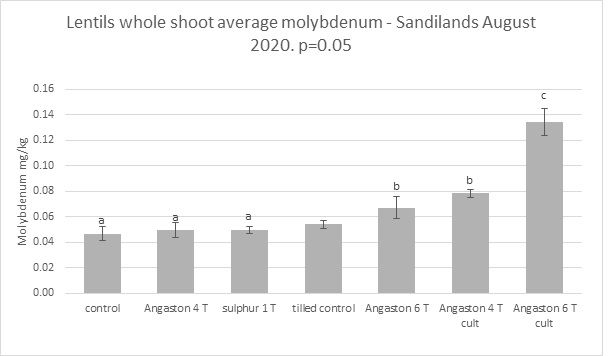
Figure 7. Average amount of molybdenum in lentil whole shoot in response to lime treatments at Sandilands 2020 (n.b. there are no critical levels specific to lentil, however <0.3 mg/kg is considered low for field peas).
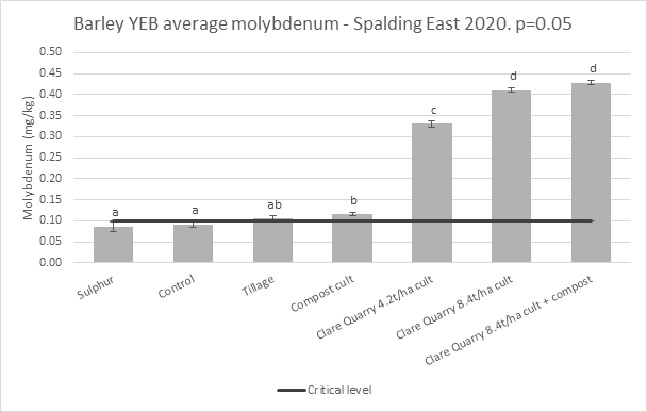
Figure 8. Average amount of molybdenum in barley YEB’s in response to treatments at Spalding East, 2020.
At many sites, the level of plant manganese was reduced in response to lime treatments, although deficiency levels were not reached at any site monitored (Figure 9). This response will be monitored as lime becomes more available in subsequent years. Notably, where no lime was applied the lentil plant manganese levels at Sandilands were close to the manganese toxicity level of chickpea - no toxic levels are available for lentils.
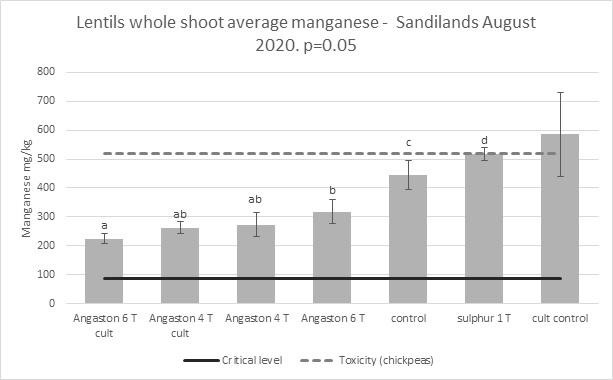
Figure 9. Average amount of manganese in lentil whole shoot in response to treatments at Sandilands, 2020.
Answers to key questions
Lime quality
Lime quality impacted response time at older trial sites, Tungkillo and Wirrabara, where finer limes with higher neutralising values produced more rapid pH changes and crop responses where the same rates were applied (Tungkillo) or rates were modified to account for the neutralising value (Wirrabara) However, on the new trial sites, response to lime quality in the first year or two was small. Stratification below 75mm was still evident under no-till at Wirrabara, several years after the lime treatments.
Lime rate
Higher lime rates (4-6t/ha) produced greater responses in combination with tillage at Sandilands and in the first 4 years after application at Wirrabara and Tungkillo. These rates are significantly higher than those used by most growers.
Incorporation
Dry matter responses to lime applications were greater in cultivated plots compared to top-dressed lime without incorporation at Sandilands. Response to tillage was both positive and negative at various new sites, with and without lime.
Deep ripping with lime gave a good result at a trial site at Sandilands and deep ripping in combination with cultivation and lime was the best treatment at Yumali in year 1.
At an old demonstration site at Koonunga (Nietschke) lime was applied at 7.8t/ha (as two split applications, 2014 and 2017) and surface applied. In 2017 an additional treatment was applied adjacent to the trial where only 3.8t/ha of high quality lime was incorporated with a mouldboard plough to around 15cm to rapidly address a major subsoil acidity issue in the paddock. Monitoring of the site showed the mouldboard plough immediately correctly subsoil pH while for the surface applied it took five years to reduce the aluminium at 20cm to safe levels for crop growth. This reinforces the approach that once signs of subsoil acidity become evident, it is better to address ongoing acidification immediately, rather than waiting and trying to ameliorate a major problem in a few years’ time.
Complementary products
Gypsum
Application of gypsum produced a negative response at some sites in 2019, however, in 2020 a lime plus gypsum treatment at Koonunga and Sandilands produced a positive crop response. High rates of gypsum can make molybdenum deficiency worse, where deficiency is an issue.
Manures
The application of chicken manure at Mallala and cow manure at Spalding East, produce a positive response, particularly dry matter. Although at Mallala, a fertiliser equivalent gave a similar result. Compost alone at Mallala increased substantially the number of nodules on roots in comparison with un-limed plots. The benefits from compost are expected, in part, to be due to the boost in legume nodulation and nitrogen fixation rather than the ability of the organic matter to ameliorate the soil acidity.
Clay
The application of clay substantially increased barley dry matter and yield at Yumali, but had only a minor impact on oats at Lameroo.
Conclusions
Recent results from old lime trials demonstrate the benefits of good quality lime with fine particle size and high neutralising value which produced more rapid increases to soil pH, and crop responses compared to inferior lime sources.
Results achieved from trials conducted on new sites seem to highlight that incorporation of lime provides a quicker response and return on investment, although responses appeared to be slow in some situations even with tillage. Low pH at depth can be corrected by the incorporation of lime, whereas the application of very high rates to the surface without tillage will also correct the subsoil, but much more slowly.
For sandy soils, trials have highlighted the need to address multiple limitations, such as compaction or high soil strength, non-wetting and nutrient deficiencies in addition to correcting soil pH.
It should be noted that in many cases the results presented are preliminary and that data collected in coming years will provide improved information on liming practices such as appropriate rates, overcoming subsoil acidity and impacts on trace element uptake, especially in low to medium rainfall areas where little data exists.
Acknowledgements
This research was initiated by a GRDC project in collaboration with PIRSA, DEW, Riverland and Murraylands Landscape Board, Hills and Fleurieu Landscape Board. This is made possible by the significant contributions of growers through both trial cooperation and the support of the GRDC, the authors would like to thank them for their continued support. The authors would also like to thank N. Wilhelm and H. Drum, SARDI for trial support.
Useful resources
Hughes, B (2018) Tungkillo Landcare Group Lime Trials- Technical Report available from Riverland and Murraylands Landscape Board.
Contact details
Brian Hughes
Nuriootpa Research Centre, Box 245 NURIOOTPA. SA 5351
0429691468
brian.hughes@sa.gov.au
Varieties displaying this symbol beside them are protected under the Plant Breeders Rights Act 1994
GRDC Project Code: UOA1905-015RTX,
